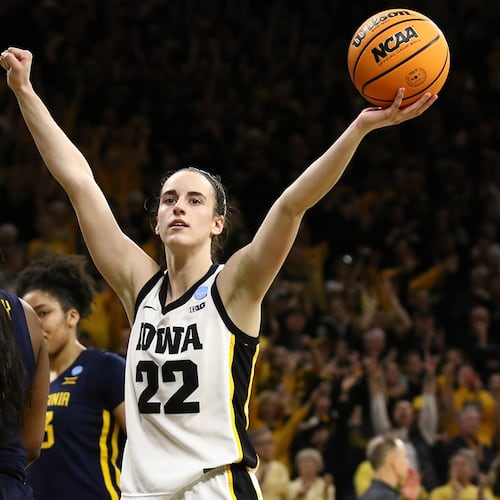In Hemingway’s “The Sun Also Rises,” a once-rich man named Mike is asked how he went bankrupt. His answer: “Gradually, then suddenly.” The Hawks appear to have completed a similar gradual-to-sudden process, but in in a far more profitable way. Or so they hope.
The Hawks hired Travis Schlenk on May 25, 2017. He began tanking in earnest at 12:01 a.m. on May 26, 2017. In the way of tanking teams, the Hawks got terrible on purpose, selling off assets and stockpiling two forms of capital — draft picks and cap space.
Most of Schlenk’s draftees — John Collins, Trae Young, Kevin Huerter, De’Andre Hunter, Cam Reddish — have either come good or shown promise. (We needn’t mention Omari Spellman.) The Hawks landed the excellent Clint Capela in a four-way trade in February, though he hasn’t played a minute as a Hawk. Hopes are high for Onyeka Okongwu, taken sixth overall in Wednesday’s draft.
This time a week ago, the best we could have said of the Hawks was that they had a nice young nucleus. We saw in last season’s Hawks — the team hasn’t played since March 11, which seems a century ago — how fragile the framework was. On Nov. 5, 2019, Collins was suspended 25 games for a positive PED test. By the time he returned, they were 6-24.
That was bad. In the grand scheme, this was worse: A team built in the image of Golden State, Schlenk’s former employer and template for success, finished last in the NBA in 3-point shooting. The Hawks made 33.3 percent of their treys, which mathematicians consider the absolute minimum to justify taking any 3-pointers. Shoot 33.3 percent on 3s and you score 100 points, same as if you made 50 percent of your 2-pointers. The league average on treys was 35.8 percent.
Even after drafting Okongwu, a big man expected to bolster their also-terrible defense, Schlenk kept mentioning that woeful 3-point number. When free agency hit, he addressed it. He signed Danilo Gallinari, a 6-foot-10 forward who has a career 3-point percentage of 38.0 and who made 40.5 percent last season. Gallinari is 32. He’s signing for three years at $61.5 million. ESPN reported that it’s the most ever paid a player on the high side of 30 who hasn’t made an All-Star team.
Credit: Atlanta Hawks
Credit: Atlanta Hawks
On Sunday, the Hawks signed Bogdan Bogdanovic for $72 million over four seasons. As a restricted free agent, the Kings have the right to match the offer and keep Bogdanovic. Given that they’d tried to trade him to Milwaukee this month — the deal fell apart — it’s hard to imagine they’d deem him indispensable. Bogdanovic is a guard. He’s 28. His career 3-point shooting percentage is 37.4. Follow him on Twitter @LeaderOfHorde.
Tony Snell, acquired from Detroit for Dewayne Dedmon, fits the profile of what NBA types call “a 3&D guy.” He can defend. His career 3-point percentage is 38.5. In baseball, you can never have too much pitching. In the pace-and-space NBA, there’s no such thing as too much shooting.
The Hawks also signed Rajon Rondo, who’s 34. He’ll be Young’s backup. It’s possible Rondo doesn’t have much left, though his performance in the Lakers’ run to their bubble championship was stellar. Still, he offers something the Hawks lacked, which is a way to score points when their best player isn’t playing. Other signings: Guard Kris Dunn, who’s regarded as a defender, and forward Solomon Hill, who is, too.
Over the weekend, the Hawks landed six established NBA players, all of whom bring attributes previously in short supply. That doesn’t make this team a finished product — it’s hard to know if even established players will mesh until they’re on a court together — but these flurry of maneuvers marks this team’s boldest step forward since the drafting of Young. Over two seasons, one of them shortened due to the pandemic, he has proved he’s bona fide. Those two seasons also showed he needed more help. It just arrived.
Did the Hawks overspend for Gallinari? Yes. But they needed shooting in the worst way. For Bogdanovic? Probably, but the same applies. A backup point guard was a must. Okongwu, Snell, Dunn and Hill should be able to guard somebody. Here’s your 13-man roster: Young, Capela, Collins, Gallinari, Bogdanovic, Hunter, Snell, Huerter, Reddish, Rondo, Okongu, Dunn and Hill. That should be enough to make the playoffs.
Schlenk has had four drafts and seven No. 1 picks, four of them among their year’s top 10. His unspent cap money has, assuming the Kings don’t match Bogdanovic’s price, just been spent. It’s still a youngish team, but Capela, Gallinari, Bogdanovich, Snell, Dunn and Rondo are 26 or older. Schlenk made a deft move in hiring Nate McMillan, who has worked 16 NBA seasons as a head coach an who has a reputation as a defensive specialist, as an assistant to Lloyd Pierce.
The architect of this teardown has sent a clear message: The tanking is over. It’s time to win. If the winning doesn’t start posthaste, owner Tony Ressler will have cause to ask, “We’ve done the ‘gradually’ — when does the ‘suddenly’ commence?”
About the Author
The Latest
Featured



